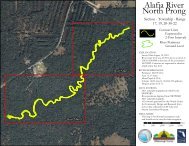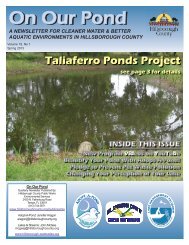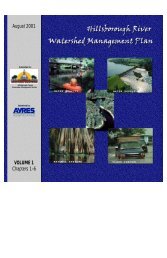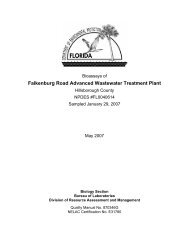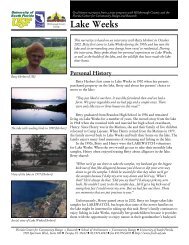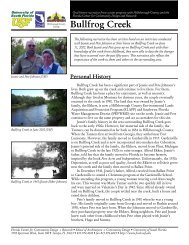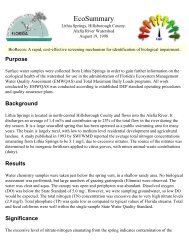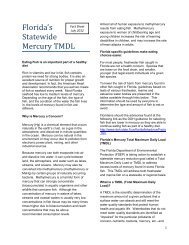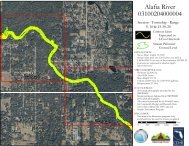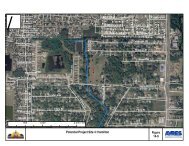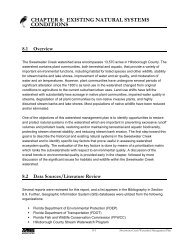Rocky Brushy Creek Watershed Mgmt. Plan (2007) -- Part 2
Rocky Brushy Creek Watershed Mgmt. Plan (2007) -- Part 2
Rocky Brushy Creek Watershed Mgmt. Plan (2007) -- Part 2
You also want an ePaper? Increase the reach of your titles
YUMPU automatically turns print PDFs into web optimized ePapers that Google loves.
EXISTING NATURAL SYSTEMS CONDITIONS8.5.9.1 Exotic <strong>Plan</strong>tsAn exotic plant is a non-indigenous species, or one introduced to this state either purposefully oraccidentally. A naturalized exotic is a non-native plant that has reproduced on its own eithersexually or asexually.Approximately 1.7 million acres of Florida's remaining natural areas have been invaded by exoticplant species. These exotic plant invasions degrade and diminish Florida's natural areas. Invasive,non-indigenous plants are non-native plants that have invaded Florida's forests and wetlands. Theyreplace native plant species and often form exotic monocultures. In many cases, these stands ofexotic plants are not useful to the state's wildlife, which have evolved to depend on native plants forfood and shelter. Native animals are rarely able to adapt to new exotic plants. Animals that dependon native plants will move away or even become extinct if exotic plants replace too many of ournative plants. Some of the effects of invasive plant species include:• decrease in biological diversity of native ecosystems• poisoning of some wildlife and livestock species• reduction of aquatic habitat for native fish and wildlife species, including listed species• decrease in the ecological value of important habitats for native fish and wildlife• clogging of lakes and waterways and other wetlands, impeding wildlife movementsExotic <strong>Plan</strong>t Species Control ProgramsThe FDEP’s Bureau of Invasive <strong>Plan</strong>t Management is the lead agency in Florida responsible forcoordinating and funding two statewide programs to control invasive aquatic and upland plants onpublic conservation lands and waterways. Florida’s aquatic plant management program,established in the early 1900s, is one of the oldest invasive species removal programs. With theaddition of the Upland Invasive <strong>Plan</strong>t Management Program under Florida Statute 369.252, thestate addresses the need for a statewide coordinated approach to the upland exotic and invasiveplant problem. Additionally, Hillsborough County’s Land Development Code requires the removalof exotic species for newly developed areas. The Exotic Pest <strong>Plan</strong>t Council (EPPC) has played amajor role in identifying exotic species that pose a threat to natural flora. The EPPC wasestablished in 1984 for the purpose of focusing attention on:1. impacts to biodiversity from exotic pest plants;2. impacts of exotic plants to the integrity of native plant community composition and function;3. habitat loss due to exotic plant infestations;4. impacts of exotic plants to endangered species primarily due to habitat loss and alteration(e.g., Cape Sable Seaside Sparrow);5. the need to prevent habitat loss and alteration by comprehensive management for exoticplants;6. the socioeconomic impacts of exotic pest plants (e.g., increased wildfire intensity andfrequency in Melaleuca);7. changes in the seriousness of exotic pest plants and to indicate which are the worst8-36<strong>Rocky</strong>/<strong>Brushy</strong> <strong>Creek</strong> <strong>Watershed</strong> Management <strong>Plan</strong>



